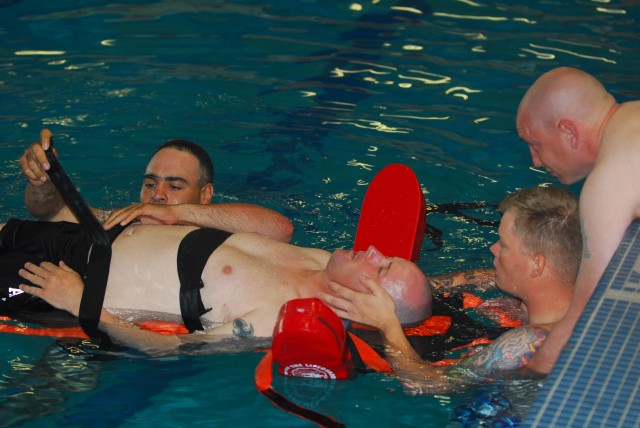FORT HOOD, Texas- Soldiers from the 1st Brigade Combat Team, 1st Cavalry Division received more than Soldiering skills training this past week.
Soldiers were selected from each battalion within the brigade to participate in Fort Hood's annual Military Lifeguard Training at Abrams Physical Fitness Center from April 11 to 15.
For most, a duty week poolside would seem like a dream, but for Sgt. Thomas McCormick and Spc. Christopher Gordon, it requires more than flip flops, swim trunks and swimming skills.
Every morning participants warmed up with a 500-meter swim.
"The 500-meter swim every morning was a decent cardio workout," said McCormick assigned with Company A, 2nd Battalion, 5th Cavalry Division.
"You don't feel the soreness and fatigue at first," said Gordon with a chuckle, "but when you get out of the pool you feel it!"
But the daily 500-meter swim was just the beginning of multiple tasks and tests the Soldiers would have to perform to attain their certifications in lifeguard; cardiopulmonary resuscitation; automated external defibrillator; and blood borne pathogens from the American Red Cross.
Soldiers had to pass a 100-meter brick swim, first aid, CPR, a spinal injury rescue exercise, swim tests and other various rescue exercises.
"At first I was scared to death. I didn't know what to expect," said Gordon, assigned to Headquarters and Headquarters Company, Brigade Support Troop Battalion. "One of the hardest parts for me was going under for the brick, but I really enjoyed the training and recommend it."
The brick swim test consist of the Soldiers swimming from the four-foot end of the pool to the 12-foot end, going under to recover a 10 pound brick. They then have to swim on their backs while holding the brick with both hands in under one minute and 40 seconds.
Another test is the back-board rescue, an exercise designed for victims suffering from back, neck or head injuries.
Sgt. William Taylor, assigned to the 3rd Squadron Battalion, 3rd Armored Cavalry Regiment, had to complete the same training when he started lifeguarding for the military and eventually became an assistant instructor for the training.
"Most Soldiers have the most difficulty with bringing a victim up from the bottom of the 12-foot end of the pool, a lot of them freak out because they can't hold their breaths that long," he stated, "But as they keep practicing they get better."
"Having to hold your victim and tread water at the same time was difficult," agreed Gordon.
Soldiers practiced rescuing a panicked victim with a simulated head, neck or back injury at the 12-foot end of the pool. Once the Soldier was able to assure the victim they were going to be okay and secure a good hold on them, they had to swim with their victims in a head-chin support position.
When the Soldier gets their victim close enough to the pool wall, they are assisted by another lifeguard who supports them with a rescue tube, assisting them in their efforts and supporting the injured victim with a rescue tube under their legs to help them float.
The lifeguard then treads water around the victim multiple times, securely strapping their legs, arms and head one-by-one onto a back-board. Once the rescue team is sure they have fastened all straps and has the victim's neck stabilized, they pull the victim from the water while on the back-board.
Another test depends on whether the Soldier is being assigned to a pool or lake area. If the Soldier was being assigned to a pool, they had to pass a 300-meter swim that consisted of freestyle and breaststroke swimming styles.
If the Soldier was being assigned to a lake area, they had to pass a 500-meter swim that consisted of a variation of the same two swimming styles.
Once Soldiers perfect their skills and pass their tests they are certified as Lifeguards. After the training they are assigned to one of the eight local pools and lakes in the local area.
"I think it's great that service members support our local pools. It helps us a lot and it helps them also, it gives them a break from their normal duty," said Jody Valdes, Aquatics director of the Military Lifeguard Training.
"It was a fun, good experience," said Gordon "I met a lot of new people too."




Social Sharing